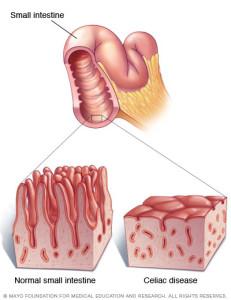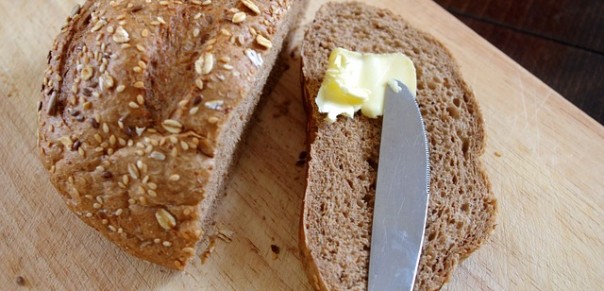Gluten is a protein found in glutinous grains: wheat, rye, barley and oats (although the debate about the gluten, glutenin, avenin and gliadin content in uncontaminated oats is still highly controversial) and their hybrids including: spelt, kamut, triticale,bulgur and graham among others. Just like the name implies(GLUE-ten), gluten is a very sticky protein that gives bread and other baked good their stretchiness (think pizza dough) and tenderness. Over the centuries, we have bred wheat and other glutinous grains to contain more and more gluten.

Courtesy of www.mayoclinic.com
Many people are gluten sensitive; ranging from celiac disease where gluten flattens the intestinal villi making the absorption of nutrients increasingly difficult requiring strict lifelong adherence to a gluten-free diet to non-celiac gluten sensitivity with uncomfortable symptoms without necessarily suffering serious long term effects.
People with many different diseases such as irritable bowel syndrome, Crohn’s disease, endometriosis, functional dyspepsia and depression among others often do have a reduction of symptoms while following a gluten-free diet. It isn’t a cure of any of these diseases, but it does help many people feel better and improve the quality of their lives. This is extremely important in my opinion and it is often very empowering to be able to take back some control over your health from a disease that commonly feels like is completely out of your hands. The problem is that so many consider going gluten-free to be a magic cure-all for everything from obesity to HIV and this just isn’t true.
It is very easy for many people going gluten-free to fill up on a lot of gluten-free processed foods which does more harm than good. Many of these processed gluten-free foods, such as bread, pasta, baked goods, bars and breakfast cereals are loaded with highly refined carbohydrates, corn, potato and tapioca starches and a variety of gums, binders and fillers that are detrimental to health. They also tend to be very low in dietary fiber, protein, minerals, vitamins and antioxidants.
It is much better to choose unprocessed whole foods that are naturally gluten free such as quinoa, sprouted buckwheat, legumes, sprouted brown and wild rice, sweet potatoes, squash, and of course plenty of fresh produce, lean proteins and healthy anti-inflammatory fats and oils. Therefore it is extremely important for those going gluten-free to work with a qualified nutritionist to follow a balanced, whole foods diet rich in all the macronutrients, micronutrients, antioxidants and fiber one needs to be healthy.
Love what you are reading? Stay in the loop and never miss a recipe; subscribe to our FREE Nutritionista ezine for free expert tips, success strategies and delicious healthy recipes and receive Erin’s exclusive guide of the Top Ten Foods to Banish From Your Kitchen ($24.99 value) absolutely free! Get ready to nourish yourself sexy!
© 2013 Nutritionista. Erin Luyendyk, RHN. All rights reserved.
All material found on www.thenutritionista.ca is intended as general educational material only and should not be considered medical or nutritional advice. It is not intended to diagnose, treat, or cure any medical condition and has not been evaluated by the FDA. Please consult with your personal physician before implementing any health, nutrition, supplement or exercise program to ensure its safety and suitability for your specific individual situation


